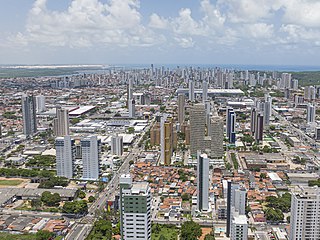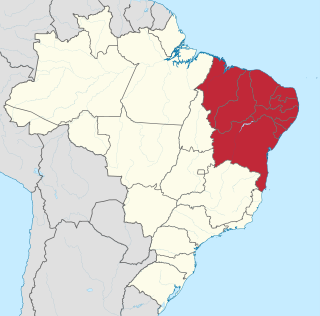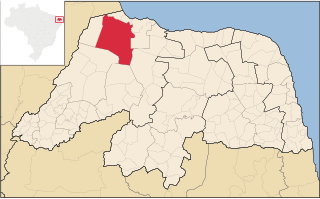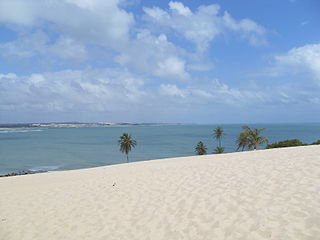
Ceará is one of the 26 states of Brazil, located in the northeastern part of the country, on the Atlantic coast. It is the eighth-largest Brazilian State by population and the 17th by area. It is also one of the main tourist destinations in Brazil. The state capital is the city of Fortaleza, the country's fourth most populous city. The state has 4.3% of the Brazilian population and produces 2.1% of the Brazilian GDP.

Rio Grande do Norte is one of the states of Brazil. It is located in the northeastern region of the country, forming the northeasternmost tip of the South American continent. The name literally translates as "Great Northern River", referring to the mouth of the Potenji River.

Natal is the capital and largest city of the state of Rio Grande do Norte, located in northeastern Brazil. According to IBGE's 2022 estimate, the city had a total population of 751,300, making it the 19th largest city in the country. Natal is a major tourist destination and an exporting hub of crustaceans, carnauba wax and fruits, mostly melon, sugar apple, cashew and papaya. Natal is Brazil's closest city to Africa and Europe, its Greater Natal International Airport connects the city with many Brazilian destinations and also operates some international flights. The city was one of the host cities of the 2014 FIFA World Cup.

The Northeast Region of Brazil is one of the five official and political regions of the country according to the Brazilian Institute of Geography and Statistics. Of Brazil's twenty-six states, it comprises nine: Maranhão, Piauí, Ceará, Rio Grande do Norte, Paraíba, Pernambuco, Alagoas, Sergipe and Bahia, along with the Fernando de Noronha archipelago.

Brazil is geopolitically divided into five regions, by the Brazilian Institute of Geography and Statistics, which are formed by the federative units of Brazil. Although officially recognized, the division is merely academic, considering geographic, social and economic factors, among others, and has no political effects other than orientating Federal-level government programs. Under the state level, they are further divided into intermediate regions and even further into immediate regions.

The sertão is the "hinterland" or "backcountry" of Brazil. The word refers both to one of the four sub-regions of the Northeast Region of Brazil or the hinterlands of the country in general. Northeast Brazil is largely covered in a scrubby upland forest called caatingas, from the Tupi language, meaning white forest, since leaves fall during dry season, donning all vegetation, mainly bushes and small trees, now reduced to bare branches and trunks, in its characteristic very light grayish, or off-white, hues. Its borders are not precise. Due to lengthy and unpredictable droughts it is an economically poor region that is well known in Brazilian culture, with a rich history and folklore. The sertão is also detailed within the famous book of Brazilian literature Os Sertões, which was written by the Brazilian author Euclides da Cunha.

Parnaíba is a city in the Brazilian state of Piauí. Having a population of over 150,000 inhabitants according to IBGE's 2020 report, it is the second most populous city in the state, after the capital Teresina. It is one of the four coastal municipalities in Piauí.

Mossoró is the second most populous city in the state of Rio Grande do Norte, Brazil, and also the largest municipality of that state. It is equidistant from Natal, the state capital of Rio Grande do Norte, and from Fortaleza, the capital of the state of Ceará. It is also in the heart of Brazil's salt production area. Situated in the Oeste Potiguar mesoregion, Mossoró is the country's largest land-based petroleum producer.

The agriculture of Brazil is historically one of the principal bases of Brazil's economy. While its initial focus was on sugarcane, Brazil eventually became the world's largest exporter of coffee, soybeans, beef, and crop-based ethanol.

Touros is a municipality in Rio Grande do Norte, Brazil. It is known as "Brazil's Corner" because it is located at the northeast corner of the country, being the closest South American city to Africa. Touros has many fish, and there is a nearby seawater basin in the ocean formed by banks of coral.

Cajueiro da Praia is one of the four coastal cities of Piauí, Brazil.

The Natal Dunes State Park "Journalist Luiz Maria Alves", or simply the Dunes Park is a state park in the state of Rio Grande do Norte in the Northeast Region of Brazil. It protects an area of dunes and native vegetation along the coastal highway.
"World's largest cashew tree" may refer to one of two trees in Brazil:

Events in the year 1988 in Brazil.
The Miss Brazil World 1996 pageant took place on October 11, 1996. Each state and the Federal District competed for the title of the Brazilian Crown for Miss World. The winner entered Miss World 1996. Anuska Prado of Espírito Santo ended being the winner at the end of the contest.
Miss Brazil CNB 2019 was the 30th edition of the Miss Brazil CNB pageant and the 5th under CNB Miss Brazil. The contest took place on September 3, 2019. Each state, the Federal District and various Insular Regions & Cities competed for the title. Jéssica Carvalho of Piauí crowned her successor, Elís Miele Coelho of Espírito Santo at the end of the contest. Miele represented Brazil at Miss World 2019. The contest was held at the Dall'Onder Grand Hotel in Bento Gonçalves, Rio Grande do Sul, Brazil.
Miss Brazil CNB 2018 was the 29th edition of the Miss Brazil CNB pageant and the 4th under CNB Miss Brazil. The contest took place on August 11, 2018. Each state, the Federal District and various Insular Regions & Cities competed for the title. Gabrielle Vilela of Rio de Janeiro crowned her successor, Jéssica Carvalho of Piauí at the end of the contest. Carvalho represented Brazil at Miss World 2018. The contest was held at the Hotel do Bosque in Angra dos Reis, Rio de Janeiro, Brazil.
Miss Brazil World 2011 was the 22nd edition of the Miss Brazil World pageant and 6th under MMB Productions & Events. The contest took place on August 13, 2011. Each state, the Federal District and various Insular Regions competed for the title. Kamilla Salgado of Pará crowned Juceila Bueno of Rio Grande do Sul at the end of the contest. Bueno represented Brazil at Miss World 2011. The contest was held at the Hotel do Frade in Angra dos Reis, Rio de Janeiro, Brazil.

André de Albuquerque Square, also popularly known as Red Square, is located in the Cidade Alta neighborhood, in Natal, capital of the state of Rio Grande do Norte. The square, named after the revolutionary André de Albuquerque Maranhão, who fought on the side of the Pernambuco rebels, marks the geodesic point of the city and also its zero milestone.
















